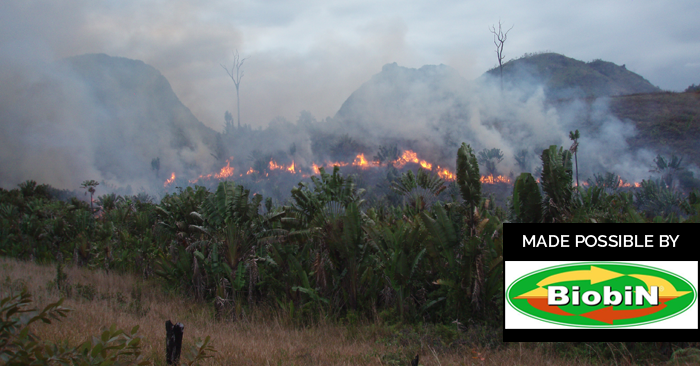TRANSCRIPT:
EM: So Peter you just came back from a two-month trip to Madagascar. How did that come about?
PA: I was hired a year ago when I was in France and I was teaching some gardening and composting classes, and…. So anyway, I was approached by this Frenchman and he told me about…that he has this, not much financial backing but a small NGO in France and they were doing work in Madagascar; in kind of the north-west area of Madagascar, the dryer side of the island, in a fairly remote area. Very poor: no running water, no electricity. And they’d basically built a small village where they had a school for little children. And then they also had some high-school students that were coming from further away, and they were trying to gain some food security, and they were just having a lot of difficulty.
EM: Right, and they sent you there to help them out. What were the main troubles they were having?
PA: So, what I’d discovered was: first of all, that side of the island had been deforested probably two hundred years or more ago. The cattle are a very import part of their diet, and a very important part of their culture, and so what they were doing was that they were burning the range right before the rainy season to burn off all the weedy vines, and the small weedy palm trees…. They’re burning it all off to create new grasses for the cattle. Well anyway, so I get there and I see this deforestation, I see this slash-and-burn, and terrible soil erosion – so I immediately saw, okay, we got to deal with erosion control, we got to deal with soil fertility, and we need to capture the water.
EM: Right. And regarding food: you told me that they were trying to grow rice, and I imagine that was quite a problem?
PA: Yeah, the property – there was no really low-level land for rice farming. Rice farming has to be done – when you’re dry farming it you need to have flat land and you need to be down in the low valleys, in the natural run-off areas, and we didn’t have any terrain like that at this village. We were on kind of a sandstone bluff, and then it would drop down to what would turn into a streambed when it rained, and then we had another hill going up the other side. So – and very few trees – a few palm trees here and there, a few mango trees here and there…you know, mostly everything had been burned off in the past.
EM: Right, and how were they for water generally then?
PA: Basically, when I got to the village they had two wells – hand-dug wells – and it was, they were very shallow. And they had planted some trees, maybe a year at the most earlier, and they were having to hand-water the trees to keep them alive during the dry season. And in one day of watering, they could take the well all the way to the bottom.
EM: That’s quite a dire situation.
PA: Yeah…
EM: Can you list, then, the key things you decided to do to help?
PA: Right…I knew we had to do some earthworks to capture the water, and replanting trees to help hold water in the soil, digging berms and swales to help hold the water and recharge the water table…and then soil fertility.
EM: Right, and there were some big challenges when it came to improving soil fertility, wasn’t there?
PA: Yeah, so I’ll tell you what – here’s what happened was…it turned out that the students that were there – the high-school students that I was supposed to be teaching compost to – were mainly not available. Initially we did make a couple compost piles and…but it was too labour intensive. So, what we found was we had…we had about twenty-head of cattle and a couple goats. Some were owned by the village itself but most of them were owned by neighbours, but they were penned on our property.
And, you know, one taboo I discovered was that we could do no, like, compost toilets or humanure composting. That was completely taboo, but to work with the cow dung and the cattle manure – that was not a problem. And they didn’t know anything about using it. And so here was this cattle pen – quite a bit of manure had built-up in it, and I discovered that we had a nearby sawmill that had mountains of wood shavings and sawdust that was a waste, and they didn’t know what to do with it. So we could get that for free, just by sending some men in an ox-cart over and…. And then there was another nearby village where they grew a lot of sugarcane and they had some low ground and some flat ground, and so there was all this sugarcane waste.
So what we decided was that: due to lack of labour and equipment, that we would just spread the woodchips and saw dust and the sugarcane waste in the cattle pen, and then allow the cattle to just trod on it for a month or so – three weeks to a month – and then we just scrape it all out and use it as mulch. And we could turn it into the soil for kitchen gardens…and so on. And so, we let that be one of the major key components for our soil fertility program, rather than manually making compost and having to turn it, and adding more water and so on.
And then, on top of using the cattle to make compost for us, a lot of people have pigs as well and most of the animals just run free and the range is open-range for everyone to use. But then, we built what we call a pig tractor, which is like a portable pigpen. So we had the pig tractor with just three little piglets in it. Of course, the pigs are being fed, but we also just threw a lot of organic material inside – the same wood shavings and the sugarcane mulch, and then weeds from the garden, we’d just throw it in there – if they pigs didn’t eat it, no problem: they would just basically compost it for us.
And then, when we first built the pig tractor – right next to it, just about the same size, we planted some cover crop. So as soon as the cover crop began to flower…all these nitrogen-fixing plants have, you know, captured atmospheric nitrogen, fixed it on their root systems. So as soon as it flowers, that’s basically when the plant stops growing and starts fruiting. And that’s when it uses that nitrogen. So if you cut it at that point, then all the nitrogen – these little nodules that are fixed in the soil on its root system – remain in the soil. So then what we did was we just moved the pig tractor over and set it on top of that cover crop and the pigs just devoured it in no time. But then, they’d left all that nitrogen in the soil already.
EM: Amazing, that’s a very effective way of getting around the problem of not being able to compost!
PA: Yes, indeed it is. And then, you know, as far as the reforestation: we looked around and we searched out local trees and seedlings…like, they have some moringa, which you can plant just from a cutting, and then there was a couple other trees – some of the acacia, that the leaf can be used as fodder. And, you know, of course the acacia will also provide shade and it’s a nitrogen-fixing tree – the same as the moringa. So, we planted trees on the swales, on the berms, using the swales to capture the water to water them.
So a lot of what we did around our tree plantings was…some woodier plants and trees which were more or less weeds to us – they weren’t fodder for animals, they weren’t nitrogen-fixers, they weren’t food for humans – so those trees, we didn’t cut them down completely but we coppiced them heavily so that we could chop off the branches, lay it out as mulch on the ground, and then allow the tree to grow back out so we could come back and coppice again. And as the trees that we planted grew up larger, we kept creating a larger mulched area around the tree to hold water, to create soil, to create the environment for the microbiology to be active….
And then we started our own nursery from seeds. And I’d brought a bunch of seeds with me, various seeds of fruit trees and nitrogen-fixing trees that would work in Madagascar. And then, because we had access to bamboo – some big stems, you know: bamboo that was several inches wide at the base – and so we cut tubes that were, you know, open at both ends and we used that. We put good soil inside, and then we planted tree seeds in those, so when the seeds spouted, then the roots could only drop straight down, it couldn’t spread out. And then as soon as the seed was up about four inches or so, then we took the whole bamboo tube and we planted the seedling in the tube, in the berms. So that as the swale would soak up water, you know, the root would just drop right down through the bottom of the bamboo and get a really good, deep start. And so before I left, we planted probable sixty – sixty or eighty trees that we’d started in these bamboo tubes. Basically, we had to use just what nature was offering us. Like, we couldn’t even buy, like, plastic pots, we couldn’t even buy, like, a plastic tube, you know, to start a seed in. So the bamboo worked great like that, you know, in a years time or two years time, you know, with most of the bamboo in the soil, it’s going to rot and just be fungal food for the root system, which is great.
EM: Right, so it’s all about using nature to your advantage then?
PA: Yeah, absolutely you know, and we’re really looking at, you know…. Any permaculture design is going to begin with just getting a good assessment, you know, and talking with the people – asking them what do they want. You know, “what is it that you want?” you know? And they needed more food, they needed more fresh water, and so that’s what we concentrated on.
And then, you know, anything you plant – if you can get some compost into the soil, if you can get any kind of organic material into the soil…because we know that in natural systems, plants don’t need fertiliser, they don’t need pesticides if the system is healthy. And with a basic understanding of how plants function, and, you know, the relationship of the microbiology in the soil…when we have a basic understanding of that, we realise that early-successional plants have a very highly bacterial-dominated soil food-web because early-successional plants are annual plants – they’re soft, green tissue plants. And what decomposes soft green tissue is bacteria.
And then when we get to the end of plant-succession, when we get to old growth forests and, you know, hundreds of year old trees or thousands of year old trees – we see that we have a very fungal dominated soil food-web. And so, if you’re growing trees, then you need more fungi in the soil, and if you’re growing perennial plants – you know, shrubs and things – then you need that balance of bacteria and fungi.
And so, that’s what we were trying to teach our local farmers and the villagers there, was that: around our trees we got to get a lot of woody material and mulch, and just keep mulching. Nature mulches herself, you know, she’s dropping leaves, she’s dropping fruit…. Man, you know, when we understand that – we can build compost piles and make humus in a very short period of time. But actively composting was something we just didn’t have the equipment and the manpower for – so just, laying on layer upon layer upon layer of mulch…
EM: Yeah, and it’s absolutely amazing what you got done there in such a short time.
PA: You know, I was actually really amazed by how much we accomplished in a two-month period with myself and a couple volunteers and then, on average, ten labourors. You know, we established a tree nursery, we dug some key berms and swales, and then only then, you know, when the heavy rains came consistently and the swales remained full, that then when they reached a high level, they could run off slowly into the natural drainage system.
What we didn’t have time for on my first trip was to really work the stream bed itself with constructing gabions to slow water down and not just run right off to the rivers, and then out to the ocean. So, we feel that, you know, we should be able to have that stream running year-round in seven years, with proper earthworks.
EM: That’s incredible. And how did the locals react to all of this?
PA: Well, I think they were very excited. Especially I think some of the older men were very excited about what they were learning, and what we were doing because in two month’s time you can start to see the changes. And, you know, when they saw that “my gosh, we’re holding some water here. This water would have just run away but now it’s still sitting here two days after that last rain!” You know…
EM: Yeah, yeah. Well it must be very exciting to see it all working out.
PA: Yeah, yeah. So, I’m looking forward to going back, you know, maybe at the end of the rainy season, or like halfway through into the dry season to see what more we can do with just mulching and….
EM: Great stuff Peter, you’ll have to keep us informed about how you’re getting on!
PA: Certainly.


